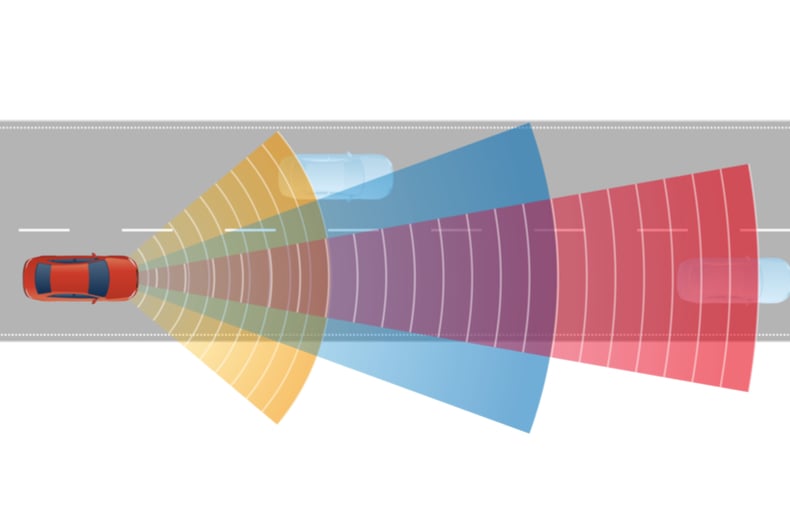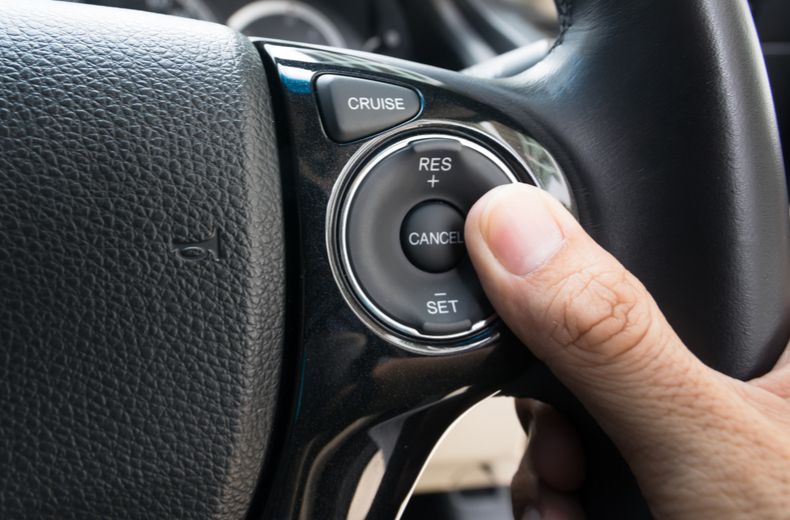While we might still be a long way off seeing truly autonomous vehicles on our roads, these the majority of cars come with some form of self-driving technology as standard.
Adaptive cruise control is just one such technological innovation, but what is it and should you be using it?
Guide contents:
- What is adaptive cruise control?
- How does adaptive cruise control work?
- What’s the difference between cruise control and adaptive cruise control?
- What are the types of adaptive cruise control?
- What are the advantages of using adaptive cruise control?
- What are the disadvantages of using adaptive cruise control?
- Is adaptive cruise control safe to use?
- Will using adaptive cruise control save me money?
- Should I buy a car with adaptive cruise control?
What is adaptive cruise control?
Adaptive cruise control (ACC) is an intelligent form of cruise control that allows vehicles to speed up and slow down automatically in order to keep pace with the traffic ahead.
ACC is also known as autonomous cruise control, active cruise control, intelligent cruise control and radar cruise control. But regardless of what it’s called, it’s become an increasingly common feature in new cars.
How does adaptive cruise control work?

In cars that feature ACC, either a laser or radar system is mounted within the front of the car that constantly scans the road ahead of you for other vehicles.
To use ACC, all you have to do is switch on the ACC system, accelerate to your desired speed, and push the “set” button. You can then adjust the speed manually using the “+” or “-” buttons accordingly.
Once you’ve set your speed, you can set the gap you wish to maintain from the car ahead using the relevant buttons, which will either be given in seconds or metres, depending on your vehicle.
If the car in front of you slows down, your car will either slow down to maintain the gap you set, or alert you to apply the brakes – which then deactivates the ACC system.
If the vehicle ahead shoots ahead suddenly, your car won’t follow suit. Instead, it will stick to the speed you have previously set, unless it catches up to another car in front.
Some of the latest adaptive cruise control systems can automatically reduce your speed according to changing limits ahead. They'll also work with automated lane keeping technology to effectively allow the car to drive down certain roads by itself - but the driver must remain in control.
What’s the difference between cruise control and adaptive cruise control?
First introduced in higher-end models back in the 1960s, traditional cruise control allows drivers to keep their car at a set speed without having to constantly keep their foot on the accelerator, regardless of the road gradient.
Early cruise control systems would simply adjust the position of the throttle to maintain a set speed, but in modern cars the system is completely electronic.
The more technologically-advanced adaptive cruise control was first introduced in the 1990s. It constantly adapts to the vehicles in front of you, meaning you’ll always be able to stay a safe distance between yourself and the car in front.
What are the types of adaptive cruise control?
There are two main types of adaptive cruise control: laser-based systems and radar-based systems.
Whichever system your car uses, the basic functionality remains the same with radars or lasers constantly scanning the road ahead for obstacles. Some cars will have two radars or lasers: one to cover obstacles close to the vehicle and one to cover further distances of up to around 200m.
Black Box Insurance
Want to pay less for your car insurance? Whether you’re a new driver or just looking to reduce costs, we can help.


What are the advantages of using adaptive cruise control?
While traditional cruise control works best for longer journeys on wide open roads such as motorways, adaptive cruise control systems can also be great on busier roads with a lot of traffic.
Not only do the ACC systems react to your surroundings, they also mean you don’t have to worry about stopping and starting in traffic jams as the system takes care of that for you, providing you with an extra layer of safety.
What are the disadvantages of using adaptive cruise control?
One of the main issues with using ACC is that there isn’t one uniform system in place across all car makes and models, so drivers may need to learn a new car’s system each time.
An ACC system may also not work properly in certain weather conditions like heavy rain or fog, if there is mud or snow on the sensors, or if roads are slippery. They may also not function properly in tunnels.
Is adaptive cruise control safe to use?
In short, yes, adaptive cruise control is perfectly safe to use. However, before using any self-driving technology, it’s important to understand your car’s system and remember that systems differ between makes.
Be aware of any situational limitations to your ACC system and remember that, as with any autonomous technology, you should always remain in complete control of your vehicle at all times and respond accordingly to the road ahead.
Remember: these systems are not infallable, and as the driver you are actively in control of the vehicle and responsible for taking over if things go wrong.
In 2024 there are some cars on the road - such as certain Mercedes-Benz and Ford models - that have 'Level 3' automated driving systems where the car can drive itself without input in limited scenarios, such as slow motorway driving. The driver must remain ready to take over at any moment.
Will using adaptive cruise control save me money?
Yes it could — depending on the type of car you drive. Maintaining a steady speed improves a vehicle’s fuel economy so if you drive a petrol, diesel or hybrid you could find yourself filling up at the pump far less often.
Similarly, being able to set the car to a particular speed will make it easier for you to stay safely within the speed limit, and less likely to pick up fines or penalty points.
What about on your car insurance? This technology has the capacity to make you a safer driver so you’d think that would be represented in your quote.
Well, the policy wording of most insurers doesn’t tend to name any car features specifically. Insurers do include the make and model of the vehicle within their underwriting algorithms though, so it would not be unreasonable to expect that a vehicle having ACC would be risk-assessed and priced accordingly.
Having ACC does not negate the drivers responsibility to drive safely.
Should I buy a car with adaptive cruise control?
If you’re the type of driver who loves having the latest bit of tech in your car then an ACC system is a must-have. Similarly, if you spend a lot of time travelling on busy motorways, ACC can provide welcome assistance when navigating traffic.
Bear in mind, though, that in some models ACC is either optional or only available in higher trim levels, which can mean an extra grand or two on the price of a new car – so it’s worth thinking about how often you would actually use the system if you had it.
Learner Driver Car Insurance
Only pay for the cover you need until you’ve passed your test. Get learner driver insurance so you can practice outside of your lessons.









